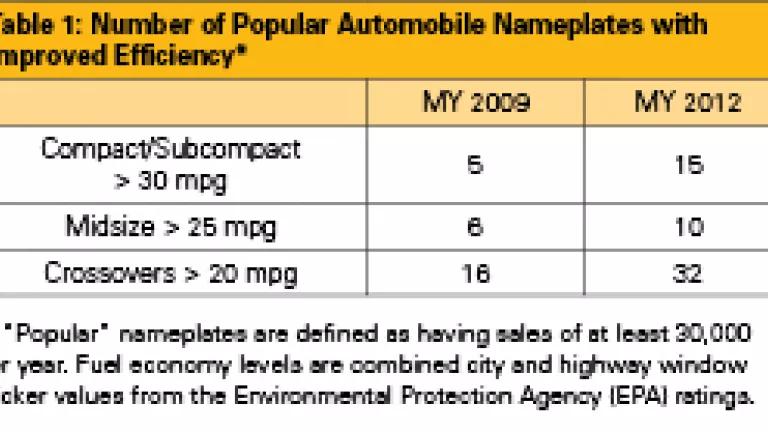Consumers Get Relief from High Gas Prices as Number of Fuel-Efficient Car Models Doubles

Thanks to stronger fuel efficiency standards, new cars and light trucks are going further on a gallon of gasoline. Automakers have made significant advancements in many popular models over the last three years that save drivers money. Consumers wishing to trade in their current guzzler for a newer version of the same model can save thousands of dollars in fuel.
As described in a new NRDC analysis titled “Relieving the Pain at the Pump”, a bumper crop of new fuel-efficient compact, midsize and family crossover vehicles are flooding the showrooms. As shown below in Table 1 of the report, the total number of popular fuel-efficient automobile nameplates[1] more than doubled from the 2009 to 2012 model years, increasing from 27 to 57. Within the compact/subcompact segment, the number of offerings that achieve over 30 mpg in combined city and highway driving tripled while crossovers getting over 20 mpg in doubled.
A shift up in fuel efficiency translates into major savings for consumers. A driver that trades in a sport utility vehicle (SUV) that gets 15 mpg for one that gets 20 mpg can save $1000 each year at $4 per gallon of gasoline and 15,000 miles per year of travel.
Model Year 2012 Fuel Efficiency Makeovers
Automakers are squeezing more miles from each gallon of fuel by revamping conventional drivetrain vehicles with fuel-saving technology add-ons, such as those shown below.

And the result? Fuel-sipping, smaller and better-optimized engines can provide all the needed oomph for lighter, more aerodynamic vehicle bodies with more gear speeds. Below, Table 3 from the new report gives examples of technologies that automakers have deployed in the latest versions of popular models. For consumers, the changes mean thousands of dollars in their pocket instead of being sent overseas for oil.

Billions More in Consumers Savings in Years Ahead from the 54.5 mpg Standard
When it comes to more fuel-efficient choices in the showroom, model year 2012 is just the beginning. This first round of improved standards will ramp up to 35.5 mpg in 2016. A second round is proposed to reach 54.5 mpg by 2025. According to the EPA and Department of Transportation, the purchaser of a new 2025 vehicle can expect to enjoy net savings of $4,400 over the life of their vehicle (net savings = fuel savings of over $6,400 minus the cost of new fuel-saving technologies of about $2000).
As more of these fuel-efficient vehicles hit the road, the savings add up. Included in our “Relieving the Pain at the Pump” analysis is a snapshot of the additional consumer savings from the second round of standards once the model year 2017 through 2025 vehicles have penetrated the on-road fleet.
In 2030, U.S. consumers will have net savings of over $68 billion in transportation bills. Consumer savings in each state will be in the millions of dollars and the top 24 states will see annual savings in the billions of dollars. You can find the savings in fuel, dollars and carbon pollution for each state in our report.
In summary, our analysis shows that there is a solution for relieving the pain at the pump. Fuel efficiency is on the rise and will continue to ramp up due to strong efficiency standards. The choice of popular fuel-efficient models in the showroom has climbed in just a few years and is poised to keep climbing. That’s good news for consumers.
[1] Nameplates are unique model names that have multiple variants. For example, the Toyota Camry nameplate includes the Toyota Camry 4 and 6 cylinder conventional and hybrid variants. The fuel economy associated with each nameplate is based on the sales-weighted average of the window sticker values for the nameplate variants.

